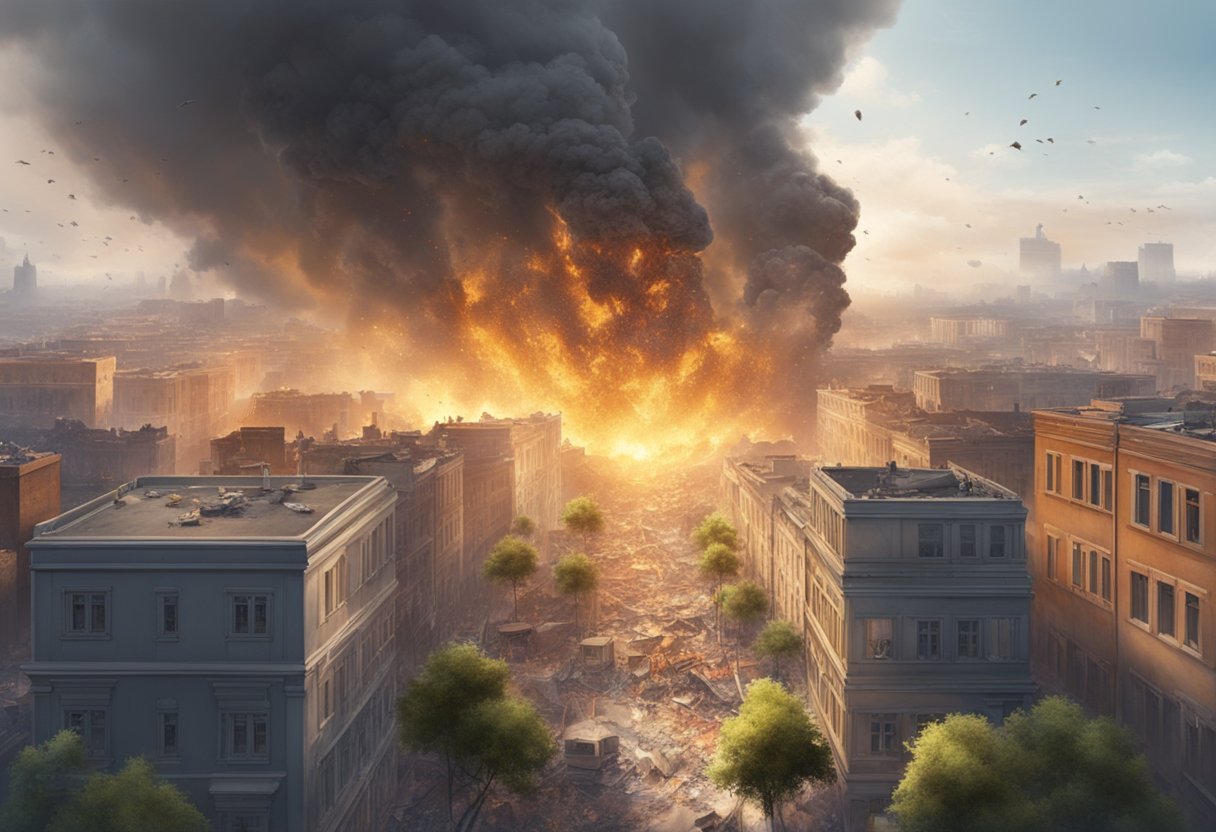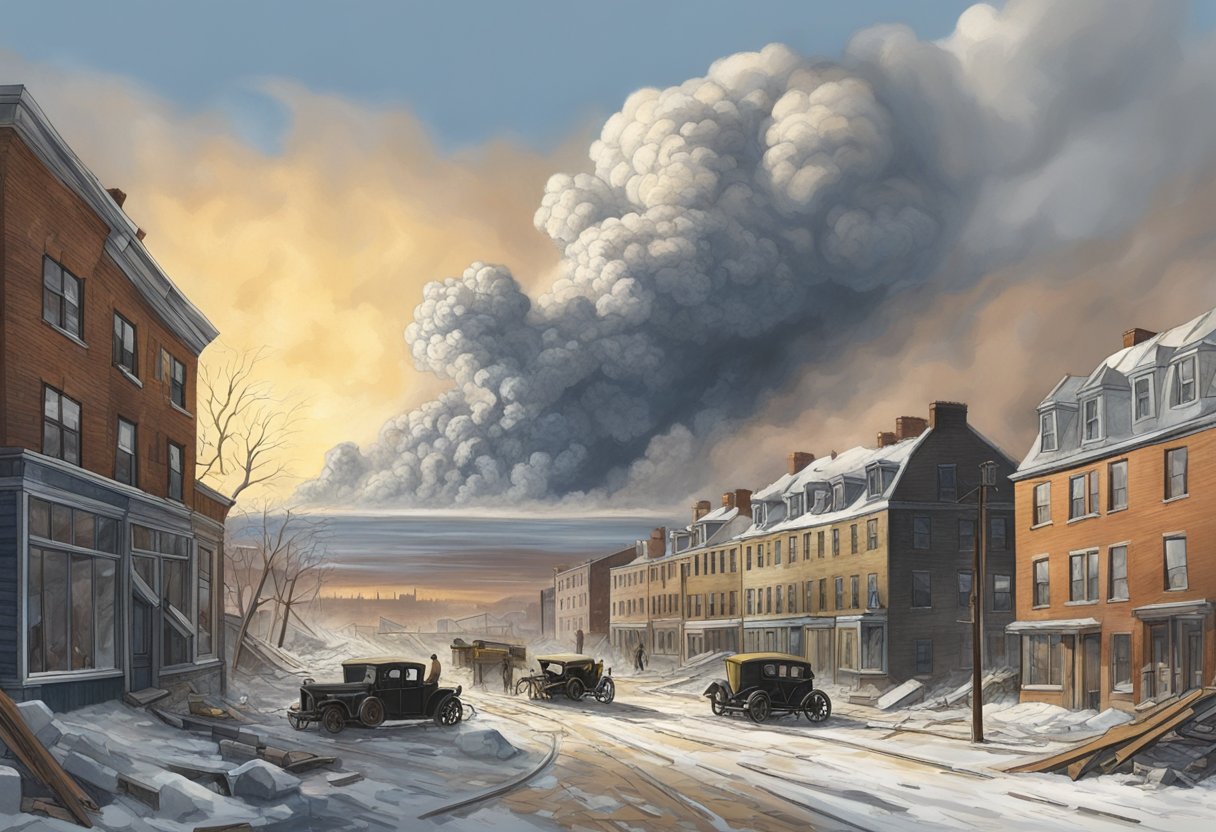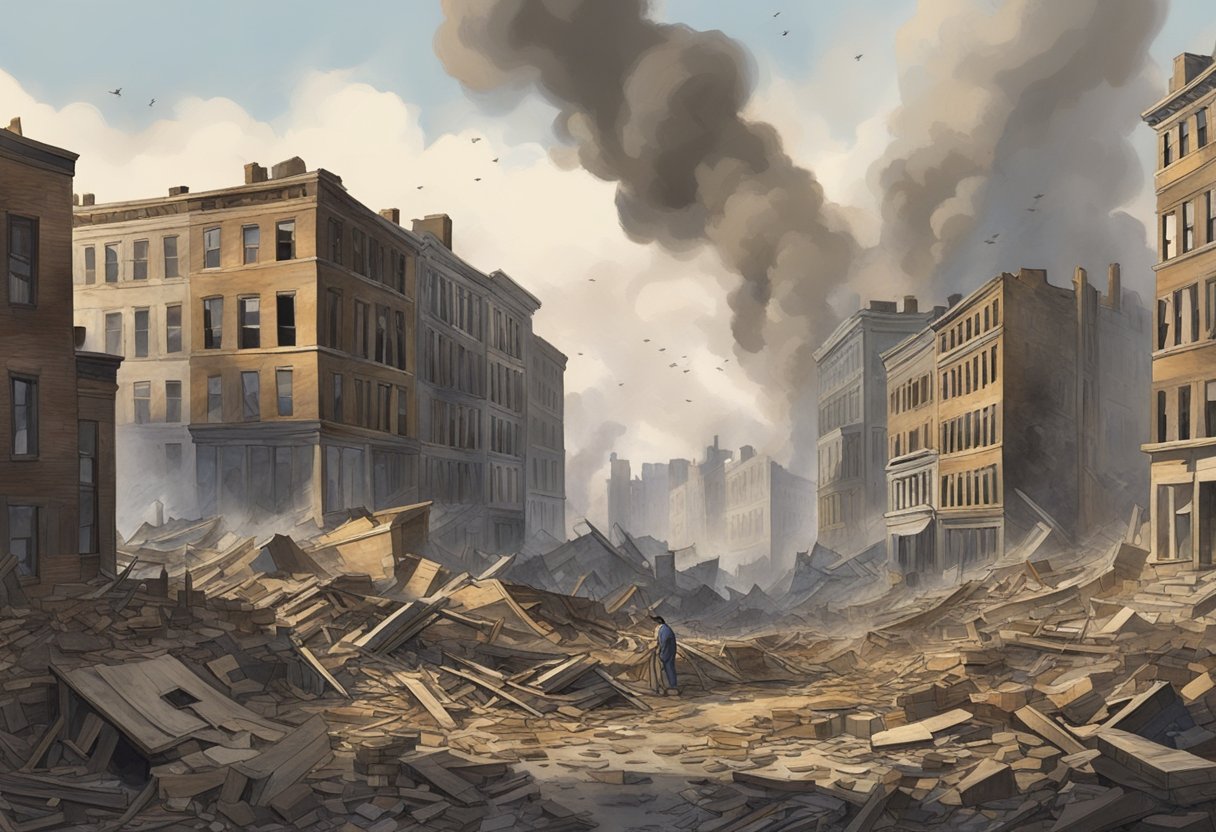The Halifax Explosion of 1917: The Largest Accidental Blast and Its Lasting Impact

On December 6, 1917, the harbor of Halifax, Nova Scotia became the site of an enormous tragedy. Two ships, the French steamship Mont-Blanc and the Norwegian cargo ship Imo, collided in the Narrows strait, leading to a massive explosion. This event, known as the Halifax Explosion of 1917, was the largest accidental blast before the advent of nuclear weapons.
The force of the explosion was so great that it flattened over one square mile of the city, leaving nearly 2,000 people dead and injuring around 9,000 more. Homes were destroyed, and the city was thrown into chaos. Eyewitnesses described the scene as apocalyptic, with buildings reduced to rubble and fires breaking out across the city.
In the aftermath, Halifax's community faced tremendous challenges as they worked to rescue survivors and rebuild their city. The Halifax Explosion remains a significant historical event, illustrating the devastating impact a single accident can have on a community.
Historical Context
In December 1917, the bustling port of Halifax played a significant role in the naval efforts of World War I. The collision and subsequent explosion of two ships, the SS Mont-Blanc and the SS Imo, had far-reaching consequences.
Halifax Port During World War I
During World War I, Halifax, Nova Scotia emerged as a vital shipping and naval hub. Its strategic location made it a primary port for assembling and dispatching convoys to Europe. Ships, laden with troops, munitions, and supplies, constantly moved through Halifax Harbor. The port was particularly busy during 1917, as conflicts intensified overseas.
Due to the heavy wartime traffic, the port saw numerous vessels, including those from the United States and Europe. Convoys gathered here before embarking on the perilous transatlantic journey. This constant movement and the merging of commercial and military navigation increased the risk of accidents, highlighting the importance of stringent harbor procedures and the role Halifax played in the war effort.
The Ships Involved
The SS Mont-Blanc, a French cargo ship, carried a dangerous payload of high explosives destined for the battlefields of Europe. On December 6, 1917, it collided with the SS Imo, a Norwegian vessel. The collision occurred in the narrow waters of Halifax Harbor. The Mont-Blanc caught fire following the crash, setting the stage for the catastrophic explosion.
The Imo was en route to New York to load relief supplies. Meanwhile, the Mont-Blanc was entering the harbor to join a convoy. Their meeting led to a miscommunication and navigational errors, resulting in the tragic collision. The ensuing blast destroyed much of the Richmond district of Halifax, exemplifying the dangers of transporting munitions in a busy wartime port.
Events Leading to the Explosion

The Halifax Explosion was a catastrophic accident caused by a collision between two ships, each carrying dangerous cargo, in Halifax Harbour on December 6, 1917. The events that led to the explosion involved critical moments of missed signals, wrong turns, and unlucky timing.
Timeline of the Collision
On the morning of December 6, 1917, the SS Mont-Blanc, a French cargo ship loaded with high explosives, entered Halifax Harbour. The ship carried TNT, picric acid, benzol, and guncotton—extremely flammable and dangerous materials.
SS Imo, a Norwegian steamship, was also navigating the same waters but was on its way out of the harbour. Miscommunication between the two ships led to the collision in the section known as The Narrows.
The impact occurred around 8:45 AM. The collision cracked open barrels of benzol on the Mont-Blanc, flooding the deck with the flammable liquid. The friction and sparks from the collision ignited the benzol, setting the Mont-Blanc ablaze.
A Chain Reaction of Tragedy
Once the fire started, Mont-Blanc drifted towards the Pier, fully ablaze. Alarmed by the fire, dockworkers, residents, and ship crews gathered to watch, unaware of the danger.
Roughly 20 minutes after the fire began, the ship exploded with the force of approximately 2.9 kilotons of TNT. The explosion caused an immense shockwave, obliterating buildings, snapping trees, and launching debris across Halifax and Dartmouth.
The explosion killed at least 1,782 people and injured 9,000 more. The force flattened over 1 square mile of the city and triggered a tsunami in the harbour. The event remains one of the largest accidental explosions in history.
The Explosion and Immediate Aftermath

The Halifax Explosion on December 6, 1917, caused unprecedented devastation. The blast resulted in widespread damage, significant casualties, and profound effects on the local community.
The Blast Wave and Its Effects
When the SS Mont-Blanc, carrying munitions, collided with the SS Imo, the resulting explosion was catastrophic. The blast produced a massive shock wave that flattened much of Halifax's north end. Buildings were destroyed, windows shattered miles away, and trees were uprooted. The heat from the explosion burned everything in its path, causing additional fires.
A tsunami followed the blast. The wave, generated by the sudden displacement of water in the harbor, compounded the destruction. Ships were lifted and thrown onshore, and the waterfront was heavily damaged. The area around Dartmouth was also affected, suffering from both the initial blast and the subsequent wave.
Casualties and Survival
The explosion killed about 2,000 people and injured 9,000 more. Many died instantly from the blast, while others succumbed to injuries from debris and collapsed buildings. Fires ignited by the explosion trapped and killed many survivors.
Survival was a matter of luck and proximity to the blast. People farther from the core, as well as those who found immediate shelter, had better chances. Rescue efforts began quickly, with local and international aid flowing into the region to help survivors and recover bodies. The disaster left a lasting scar on the community, both physically and emotionally.
Impact on Halifax and Surrounding Region

The Halifax Explosion of 1917 had devastating effects on the city and its surrounding areas. Nearly 2,000 people were killed, and thousands more were injured as a result of the blast.
Damage to Urban Landscape
The explosion occurred in Halifax Harbour, resulting in massive damage to the city's waterfront. The North End of Halifax was heavily impacted, with entire blocks flattened and reduced to ruins. The Richmond District was particularly devastated.
A tsunami followed the blast, causing further destruction along the Dartmouth Shore. Homes were obliterated, leaving many residents homeless. Buildings collapsed, and debris was scattered over a large area. The area around Bedford Basin experienced significant shockwaves, contributing to the widespread damage.
Response and Relief Efforts
In the wake of the disaster, immediate response and relief efforts were crucial. Emergency services and hospitals quickly mobilized to treat the injured. Many residents of Turtle Grove and Dartmouth also received assistance.
Relief supplies were sent from cities across Canada and the United States. Volunteers and medical personnel arrived to support the overwhelmed local services. Temporary shelters were set up to house the homeless.
Reconstruction of Halifax and its surroundings required coordinated efforts and substantial resources. The community came together, showcasing resilience and solidarity amidst one of the greatest tragedies in Canadian history.
The Aftermath and Reconstruction

The Halifax Explosion left a massive impact on the city, leading to extensive investigations and efforts to rebuild the community. Many buildings were destroyed, and a large part of Halifax, including the North End and Richmond district, required significant reconstruction.
Investigations and Accountability
After the blast, immediate investigations were launched to find out what caused such a tragic event. Authorities looked into the collision between SS Mont-Blanc and SS Imo, both anchored in the Halifax Harbour.
Blame quickly fell on the ships' captains and their crews, who were held responsible for the safety violations leading to the explosion. Trials were held to determine the exact errors, and the Nova Scotia Archives now holds detailed records of these investigations.
Knowing the root cause helped create stricter regulations around handling and transporting dangerous materials, aiming to prevent such an event from occurring again. This also led to changes in how maritime traffic was managed, emphasizing safety.
Rebuilding a Community
The explosion flattened much of Halifax’s North End, including the Richmond district. Relief efforts began almost immediately, with hospitals overwhelmed by thousands of injured people. Temporary shelters were set up to house those left homeless.
International aid flowed into Halifax, with significant help coming from Boston. Volunteers helped clear debris and construct new buildings. The Hydrostone district became one of the notable reconstruction projects, designed to be fireproof and modern.
Windows shattered across miles, but the community spirit shone through as they rebuilt brick by brick. The reconstruction wasn’t just about buildings; it also included restoring trust and ensuring better safety protocols for the future. The event is now a key part of Nova Scotia’s history archived for educational purposes.
Legacy of the Halifax Explosion
The Halifax Explosion of 1917 left a lasting impact on the city of Halifax and its people. Its legacy is reflected both in cultural memory and numerous memorials dedicated to those affected by the disaster.
Cultural and Historical Significance
The explosion had a profound effect on Halifax's identity and history. The disaster became a key event in Canadian history, often referred to as the Great Halifax Explosion. It changed the landscape of Halifax, especially the north end, which was nearly wiped out.
Africville, a predominantly Black community, was severely affected. The explosion disrupted their lives and worsened already existing social and economic challenges. The event is deeply etched in the collective memory, emphasizing the resilience of the survivors.
The Halifax Explosion is also remembered in cultural works. Books, documentaries, and academic studies have kept the story alive, ensuring that the lessons and experiences from this event are not forgotten. Its historical importance extends beyond Canada, impacting North American history as well.
Memorials and Remembrance
Numerous memorials and annual events commemorate the Halifax Explosion. One significant memorial is the Halifax Explosion Memorial Bell Tower in Fort Needham Memorial Park. This site honors the victims and the widespread destruction caused by the blast.
Every December 6th, citizens gather to remember the day of the explosion. Another notable tradition involves Boston, which receives a Christmas tree from Nova Scotia each year. This gesture thanks Boston for their immediate and significant aid following the explosion.
Other memorials are scattered throughout Halifax, preserving the memory of the disaster. These sites serve as poignant reminders of the devastation and the community's recovery, binding the past with present-day Halifax.
The Halifax Explosion in Global Context
The Halifax Explosion of 1917 remains one of the deadliest accidental explosions in history, with significant impacts not just locally but on a global scale. It serves as an important case study for understanding disaster response and the handling of explosives.
Comparisons with Other Disasters
The Halifax Explosion is often compared to other major disasters due to its scale and impact. The explosion flattened a large part of Halifax, similar to how the Great Fire of New York City in 1835 destroyed much of Lower Manhattan. The number of casualties, nearly 2,000 dead and 9,000 injured, surpasses many of the fatalities from other historical events.
It's often cited alongside the devastation of World War I, where large-scale destruction was common. Unlike natural disasters, this explosion was caused by human error and inadequate safety regulations, resembling incidents like the Texas City disaster in 1947.
Other notable comparisons include the Boston Molasses Disaster in Massachusetts, which also highlighted the catastrophic potential of industrial accidents. The explosion’s effects reached far beyond Halifax, impacting regions like Prince Edward Island and Central Canada.
Lessons for the Future
The Halifax Explosion forced a reevaluation of safety regulations globally. One of the critical lessons learned was the need for stricter controls on the transport and handling of explosives.
Governments around the Atlantic Ocean basin, including New York City, implemented new policies to prevent similar accidents. Enhanced disaster response strategies were developed, focusing on rapid evacuation and medical aid.
The explosion also highlighted the importance of international cooperation. During World War I, the lessons from Halifax influenced military strategies and civilian safety measures, ensuring better preparedness for future conflicts.
Safety protocols underwent significant changes, shaping modern practices in industries that deal with hazardous materials. These reforms echo the need for constant vigilance and adherence to safety standards to avoid another catastrophe of this magnitude.




